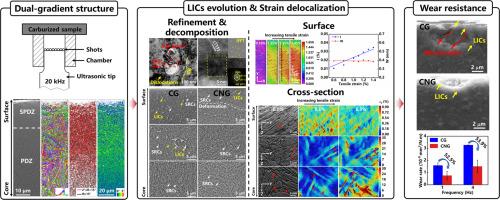Dual-gradient structure enhances wear resistance of aero-engine bearing steel by suppressing strain localization
IF 8.3
1区 材料科学
Q1 MATERIALS SCIENCE, MULTIDISCIPLINARY
引用次数: 0
Abstract
Gradient structures can significantly enhance the wear resistance of steels through the synergistic effects of heterogeneity. However, traditional surface heterostructures typically produce a single gradient. Here, we propose a novel strategy to implement a dual-gradient structure of composition and nanocrystalline, thereby enhancing the wear resistance of bearing steel by suppressing strain localization. The compositional gradient prefabricated by carburization facilitates the formation of gradient-distributed carbides and martensite, while the nanocrystalline gradient is developed further via ultrasonic shot peening. Strong dislocation movement promotes the refinement and decomposition of large-sized irregular carbides in the surface layer, significantly mitigating the initiation and propagation of cracks induced by stress localization. Additionally, the numerous nanograins in the surface layer not only contribute to the formation of a more stable and dense oxide film under oil lubrication but also create a more dispersed region of stress localization by co-sharing cyclic shear stress, thereby alleviating sliding-induced microstructural instability. Furthermore, the single compositional gradient structure tends to surface strain localization during loading, attributable to the relatively gradual transition between the hard and soft layers, whereas the dual-gradient structure facilitates surface strain delocalization across a wider stress range due to the presence of numerous nanograins creating a more pronounced strain gradient. Compared to the single compositional gradient, the unique dual-gradient structure reduces the wear rate by 52.5 % and 53.9 % at low and high-frequency sliding, respectively. This work proposes a promising design for the fabrication of dual-gradient structures to enhance the wear resistance in high-strength steels.


双梯度结构通过抑制应变局部化提高航空发动机轴承钢的耐磨性
本文章由计算机程序翻译,如有差异,请以英文原文为准。
求助全文
约1分钟内获得全文
求助全文
来源期刊

Acta Materialia
工程技术-材料科学:综合
CiteScore
16.10
自引率
8.50%
发文量
801
审稿时长
53 days
期刊介绍:
Acta Materialia serves as a platform for publishing full-length, original papers and commissioned overviews that contribute to a profound understanding of the correlation between the processing, structure, and properties of inorganic materials. The journal seeks papers with high impact potential or those that significantly propel the field forward. The scope includes the atomic and molecular arrangements, chemical and electronic structures, and microstructure of materials, focusing on their mechanical or functional behavior across all length scales, including nanostructures.
 求助内容:
求助内容: 应助结果提醒方式:
应助结果提醒方式:


